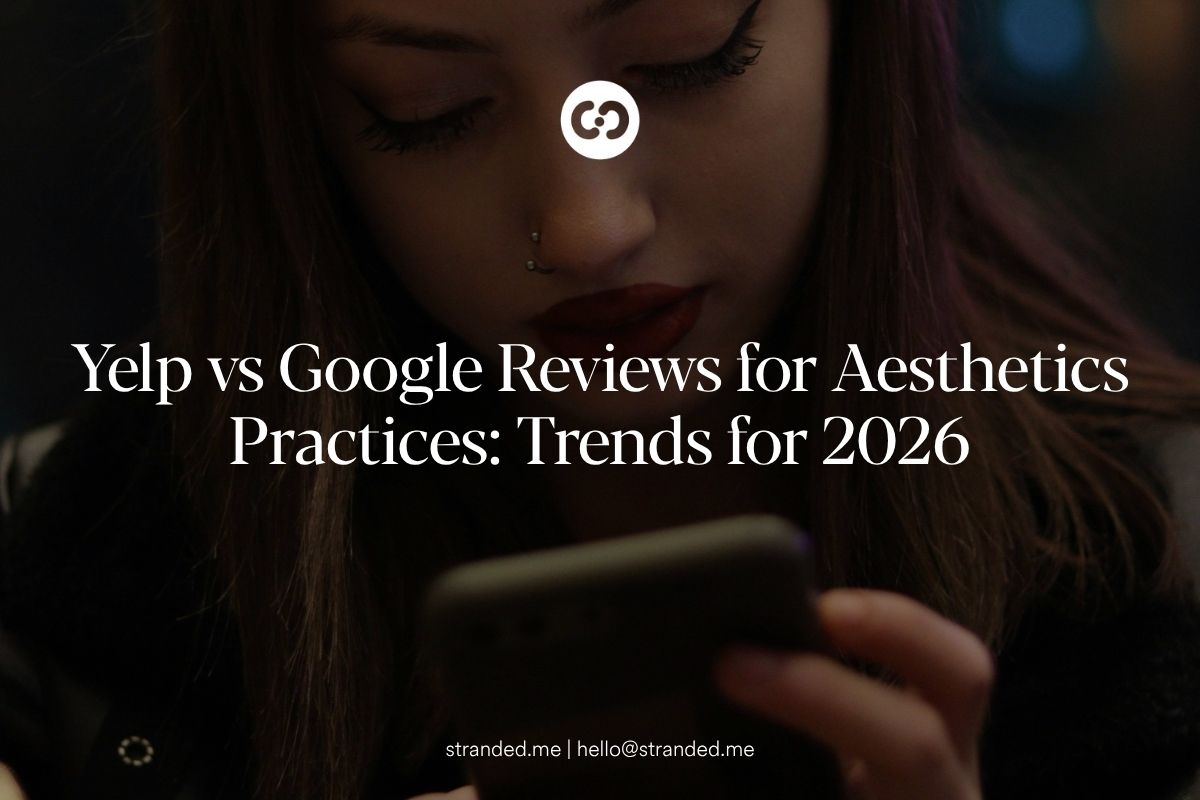
© Stranded
As we move into 2026, one question keeps surfacing for med spas and aesthetic clinics: Is Yelp still relevant, or has Google fully taken over patient decisions? Reviews are no longer “nice to have.” They shape local rankings, influence click-through rates, and convert undecided visitors into booked consults. This guide distills what matters for aesthetics practices in 2026 and how to operationalize a reputation system that supports growth, compliance, and brand trust.
Google is the first stop for most patients researching treatments or comparing clinics. A strong profile with recent, detailed reviews improves visibility in the local pack and increases conversions from search. For aesthetics, where decisions are high-consideration, patients read multiple reviews, compare comments about safety and bedside manner, and scan photos that show real outcomes. Prioritize a steady stream of authentic Google reviews tied to your core services and location.
- Optimize your Google Business Profile (GBP) with complete services, hours, UTM-tagged links, and high-quality imagery.
- Encourage descriptive reviews that mention procedures (e.g., microneedling, dermal fillers), providers, and neighborhood/city.
- Respond within 24–48 hours using HIPAA-safe language and a helpful, empathetic tone.
Yes—contextually. Yelp’s overall market share has softened from its peak, but it remains influential in dense metros and beauty-forward neighborhoods where consumers compare several options. Patients who consult Yelp often scrutinize photo galleries, pricing language, and narrative reviews before calling. Maintain a credible Yelp presence even if your primary review engine is Google.
- Complete every field: categories, services, amenities, parking, and neighborhood landmarks.
- Curate high-resolution treatment photos and staff spotlights to humanize the brand.
- Monitor and reply consistently; avoid solicitation that may trigger Yelp’s review filters.
A thousand old reviews won’t outperform a steady cadence of recent, detailed feedback. Platforms reward current, specific commentary because it signals ongoing quality. Build daily or weekly prompts into your workflow so review acquisition is continuous, not campaign-based.
Short five-star notes help, but text with procedure names, recovery expectations, and provider mentions drives stronger relevance. Visuals matter too. Patient-added photos and short videos increase credibility and engagement. Invite authentic detail; never script or gate sentiment.
Regulators and platforms continue to crack down on fake, incentivized, or gated reviews. Protect your clinic by adopting a written, training-backed SOP: neutral language, no incentives, no filtering negative feedback, and documented timing after service.
Think portfolio allocation, not platform rivalry. Make Google your core engine and Yelp your secondary trust layer, then reinforce both with on-site testimonials and structured data.
- Google (Primary): Post-visit SMS/email requests, clear review links, robust GBP, and rapid responses.
- Yelp (Secondary): Keep listings fresh, reply to reviews, ensure consistent pricing language and photo quality, avoid direct “please review us on Yelp” asks.
- Website: Embed testimonials on procedure pages with
Review / AggregateRating schema, and attribute quotes ethically.
- Trigger: After a successful appointment or follow-up, send a neutral “share your experience” message.
- Routing: Link to your GBP review form; include an alternative pathway on your site’s testimonials page (avoid Yelp solicitation).
- Tone: Thank patients for their time; do not suggest star ratings or language.
- Response: Acknowledge all reviews. For negatives, thank, apologize if appropriate, and offer offline resolution.
- Measurement: Track review velocity, response time, keyword mentions (e.g., “injector,” “natural results”), and correlation with calls/forms.
- Incentivizing reviews: Risks platform penalties and reputational damage.
- Review gating: Filtering unhappy patients undermines authenticity and violates policies.
- Template responses: Copy-pasted replies feel impersonal; personalize to the procedure and experience.
- Inconsistent NAP: Name, address, phone variations confuse platforms and users; keep them identical everywhere.
Reviews shouldn’t live only on third-party profiles. Pull standout quotes and treatment-specific commentary into your website, landing pages, and ad assets. Use schema to enhance eligibility for rich results. On PPC pages, place a review excerpt near the primary CTA to reinforce credibility at the decisive moment.
For aesthetics in 2026, the smartest move is simple: lead with Google, stay credible on Yelp, and operationalize a compliant review system that runs daily. The clinics that win will capture authentic, detailed reviews, respond with empathy, and weave social proof into every step of the patient journey—from search to schedule.
At Stranded, we design compliant, automated review systems for med spas and aesthetic practices. From Google Business Profile optimization and schema to review routing, dashboards, and training, we turn patient feedback into measurable visibility and bookings.
Book a Free Strategy Session
Yes—particularly in competitive metros. Treat Yelp as a secondary trust channel: keep the listing current, reply to reviews, and maintain strong visuals without soliciting reviews directly.
They influence local visibility. Recency, volume, and review content help searchers—and Google—assess relevance and quality.
Use neutral, post-visit messages that simply invite feedback. Avoid incentives, scripts, or gating. Document the process and train staff.
Feature testimonials on procedure pages and your homepage. Add Review / AggregateRating schema and attribute quotes appropriately.